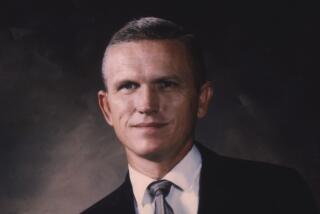When Explorer beat Sputnik
- Share via
Fifty years ago tomorrow, the United States launched its first satellite, Explorer 1, into orbit. Its success may seem to be a footnote in space history, a second-place finish to the Soviet Union’s Sputnik. After all, wasn’t it Sputnik, launched four months earlier, that represented the real scientific breakthrough and sent Americans cowering in fear at the shiny Russian ball orbiting overhead?
Not exactly. Sputnik, a “hey look at me” feat of engineering, did not throw the nation’s scientists into a panic or prompt a mad scramble to match the Soviet demonstration of power. Instead, President Eisenhower, while prodding his team for results, kept an established national space program focused on the deliberate pursuit of scientific progress, and as a result, it was the runner-up that scored a more important breakthrough for pure research.
Conceived by James Van Allen of the University of Iowa and built by the Jet Propulsion Laboratory in La Canada Flintridge, Explorer 1 carried with it instruments to detect radiation in near space and to send data back to Earth. This mission was an extension of a vast global project -- called the International Geophysical Year -- that involved thousands of scientists and technicians from almost every country.
Sputnik merely orbited Earth; Explorer made the first physical discovery in space, identifying the regions of high and low radioactivity now known as the Van Allen belts. These radioactive realms offered clues for understanding atmospheric phenomena such as the aurora borealis and the way radio waves behave over long distances. The belts also suggested that space might contain unusual and unimagined hazards.
After Explorer I, Van Allen was celebrated momentarily in the media and honored at the White House. But his fame faded quickly as astronauts with the “right stuff” appeared on the scene. This was fine with Van Allen, who was content to resume his research.
During a lifetime of space exploration, Van Allen participated in dozens of projects -- discovering, among other things, a moon circling Saturn. He was impressed by expensive manned missions, which displayed human courage and ingenuity and produced real scientific advances. But geopolitics played an enormous role in these blockbuster achievements, and when the Cold War ended, he saw few reasons to spend billions of dollars on manned spaceflights when well-built machines could do the job at far less cost and with no risk to life.
Over time, policymakers have come around to Van Allen’s point of view. Massive, government-funded human spaceflights have declined, and though the private sector keeps the thrill alive for those who can pay, the great discoveries are being made by explorers in shirt sleeves at places like JPL. Earth-bound observatories, unmanned missions and the Hubble Space Telescope generate a constant stream of spectacular new information about the universe. In the last year, we’ve learned about weather conditions on Neptune and Saturn, found hundreds of new planets and discovered astounding new facts about so-called black holes.
The exploration model that produces these results brings together thousands of people in scattered locations -- as did the International Geophysical Year project -- to contribute in small ways to big goals. Today’s explorers don’t get the attention once accorded astronauts. But they serve us better by advancing our knowledge of Earth, the planetary neighborhood and the universe beyond.
The trend would please America’s original space pioneer. A few months before his death in 2006, I visited Van Allen in his office on the top floor of the University of Iowa building that bears his name. Although he was still devoted to exploration, he became most animated when he talked about our shared purpose in life. At age 91, he spoke like a man who had time only for what is essential.
Van Allen believed that the public would support basic science in space as long as it produced real results without excessive cost. He admired the courage of the astronauts but wasn’t nostalgic for the days when Americans gathered around TVs to watch manned missions: “We’re learning more every day without great risk and expense, and that’s about right.”






